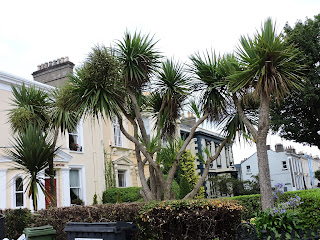This is our academic blog post considering the differences on the northwest and east coast of Ireland. This blog contains the adventures of Brad, Meghann, Elizabeth, and Eva.
~~~~~~~~~~~~~~~~~~~~~~~~~~~~~~~~~~~~~~~~~~~~~~~~~~~~~~~~~~~~~~~~~~~~~~~~~~~~
From the moment we climbed out of the coach on the windswept cliffs of Slieve League, we noticed that the temperature had drastically dropped from a few hours before when we left Greystones. Many of us climbed back onto the coach to grab scarves and hats and coats. We noticed that the Irish Sea blows slightly warmer air than the Atlantic Ocean does. As we climbed, the temperature dropped. When we gazed out over the grey expanse of the open Atlantic Ocean, the girl's hair billowed out in the wind. But when we descended on other side of Slieve league away from the cliffs to look out over the bay and town below, the wind disappeared and although still chilly, it wasn't so harsh. Our time in Derry still required several layers, and even when we went south to Westport and Achill Island, the temperature was still slightly chilly.
 |
| So much WIND! |
 |
| Rocks everywhere! |
Not only was the weather different, but the terrain was significantly changed from the east coast of Ireland. In the east, the land is relatively good and yielding to crops. In the northwest, the landscape is rough and dotted with rocks. The soil is filled with huge rocks that are scattered through mountain slopes and fields. In some places, there is only a thin layer of turf covering solid rock. In the boggy mountain sides, the ground was somewhat bouncy and moist. Imagine walking on the tire mulch that is now popular in children’s parks. That is what it felt like to walk around Slieve League.
There are also far more bogs in the northwest. All these peat bogs prevent crops from growing, but they do provide and an excellent source of fuel for the Irish throughout history and even to modern day. But to make the sod useable the Irish must spend hours of back breaking work to cut slabs of earth, turn it, dry, cut, and carry it home. As you gaze out the coach window at the green landscape flashing by, you can see white bags filled with dry sod and the ruts in the ground that have been cut out in the bogs.
 |
| Brown bogs to the left. Evergreen Forest to the right. Bright green farmland. And at the foreground... Lots of rocks. |
On the northwest coast, there is a lot of heather. Purple fields of heather stretched out for miles on mountain slopes through the bogs. On the east coast, there is a small amount of heather but gorse is far more common. Yellow dots the mountain sides instead of purple.
 |
| Pretty purple heather. |
What we noticed between the different towns was definitely their size. Some towns like Greystones branched every which way, before turning into homes and churches. Other towns like Westport you could walk through its one street in just a few minutes. What remained constant throughout Ireland was the kindness of the people. Everywhere we went we were warmly welcomed. Especially in the smaller towns, where we had heart to heart talks with some of the staff. Regardless of where we stayed, there was always amazing food waiting for us at the end of a long and tiring hike.
Greystones may be home for us, but it was a magical experience to visit the western coast. It is amazing how much the landscape, plants, weather, and towns changed 5-6 hours to the northwest.



No comments:
Post a Comment